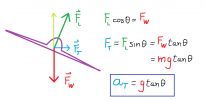Hello all, first post! I have attached my stab at the GeoGebra modeling. I considered all the different bank angles from the original video and modeled the turn radius and rate based on the info available (airspeed, bank angle). Unfortunately, we don't have any data on if these are coordinated turns or not, which could significantly impact the accuracy of the model as it would make it impossible to extract an accurate turn rate. If the turn is coordinated and level, all you need are bank angle and speed to deduce the turn rate. You can also extract turn radius from this information, but it will only be accurate if there is no wind. I think there was 100 kts of wind in this scenario, which would have a big effect on turn radius. I'm not sure how lack of wind modeling will influence our results here, but it seems like turn rate has a bigger impact than radius on the results.
To explain the model:
There is a corresponding line of bearing drawn at each point where the bank angle changes. The colors of the lines are in ROYGBV order from point 1 to point 6 respectively. As you can see the first 4 lines tend to converge and then the last two, blue and magenta, break from the pattern of convergence. The larger circle is drawn at 16NM and seems to be about where the lines start to diverge again.
My first theory is that the object is flying away from the F-18 along the first 4 lines of bearing, somewhere between 12-16NM. The last two bearings blue/magenta seem to be in opposition to this theory, perhaps due to some uncoordinated turns and/or some inaccuracies involved with the pod rotation, as they are both within the sensor azimuth range where it starts to rotate. Additionally, the rate of change of the azimuth of the pod is very rapid towards the end of the video, which made it challenging to know what angle/time to insert into my calculations. My main sticking point with this theory is that with the amount of aspect change to the object, I would think you would see more change in the actual shape of the object, although that could simply be masked by the "glare".

My second theory assumes that there are no distortions from uncoordinated turns or any other anomalies with the ATFLIR. If that is true, the only thing that made sense to me is a turning rejoin being performed with another object that is relatively close (roughly depicted by the dashed orange line). The main problem that sticks out to me about this theory is that the size of the object doesn't appear to change very much, which you would expect based on the geometry here.

A frustrating analysis as it's not definitive one way or another. I've never used GeoGebra before so it's possible I made a mistake, although I checked it over multiple times. Perhaps Mick can apply his skills to generating a more detailed model using the extracted bank information.
Finally, I can't think of a single aerodynamic concept that Chris has portrayed correctly in his videos, so if anyone is confused on these topics, please feel free to ask (I'm a commercially/instrument rated pilot with over 3k hours).

